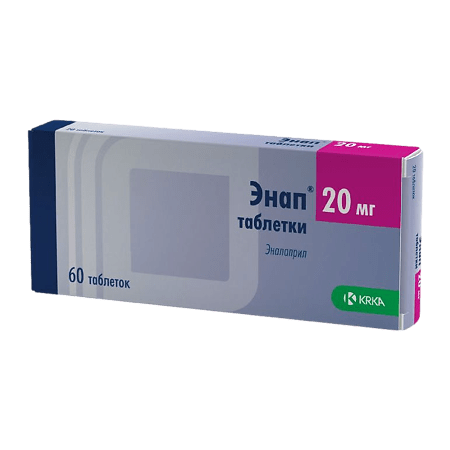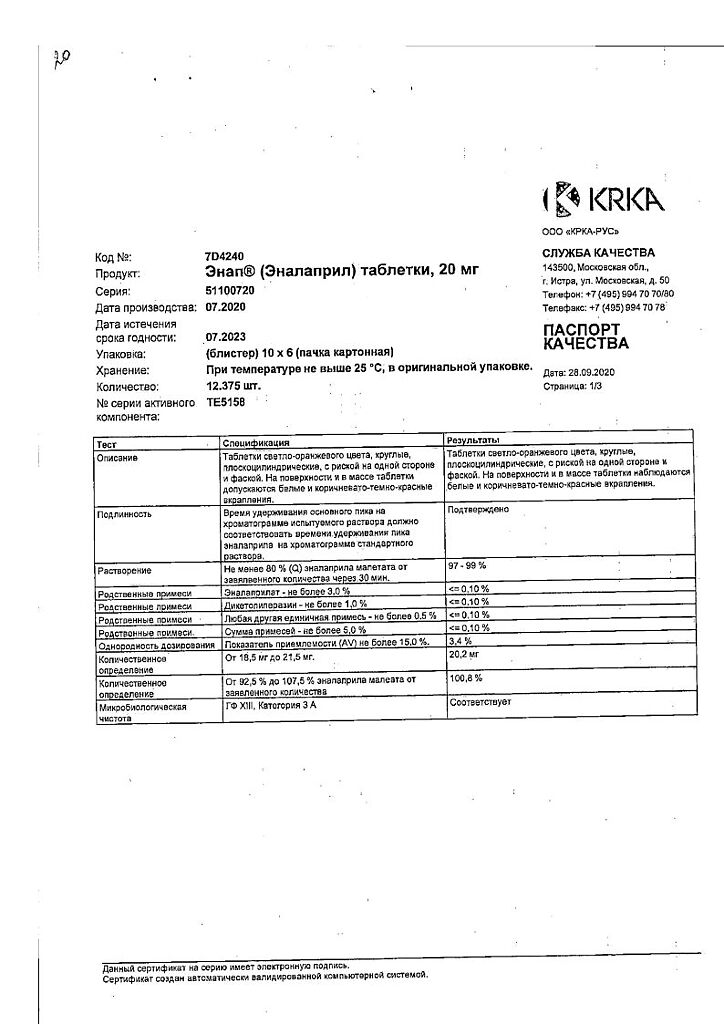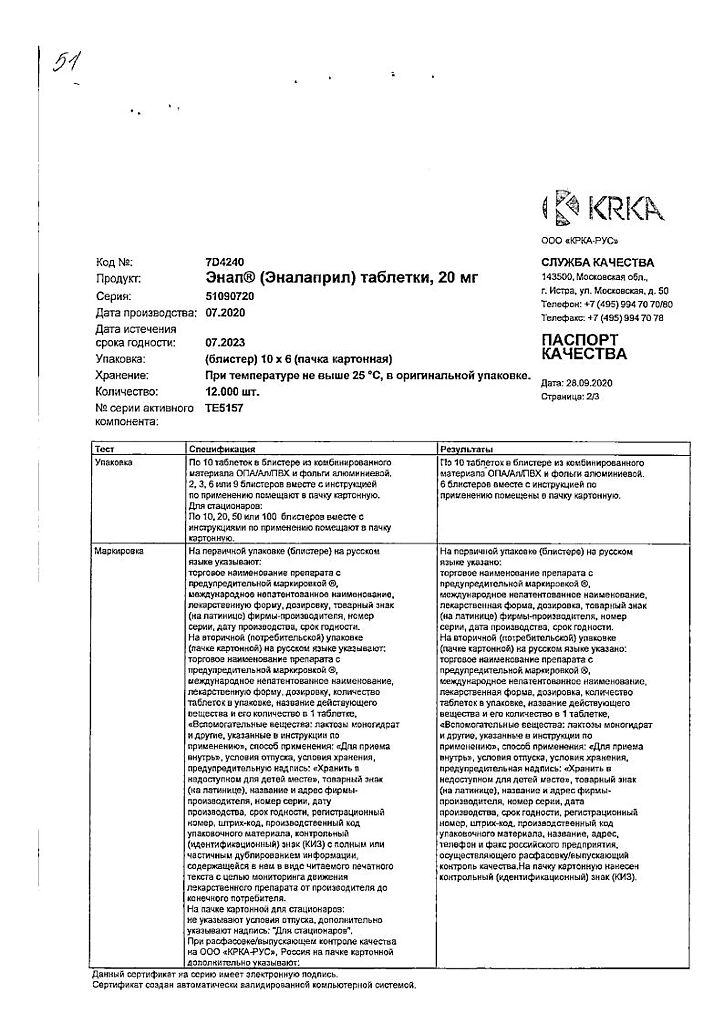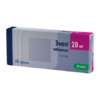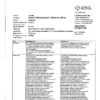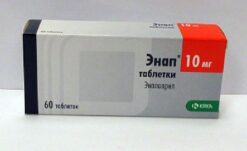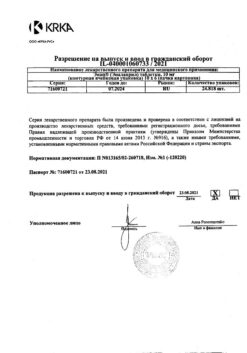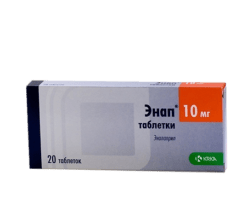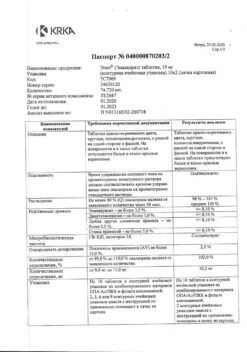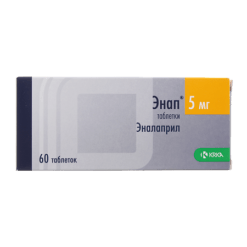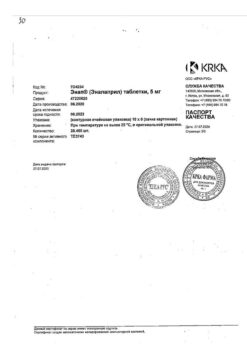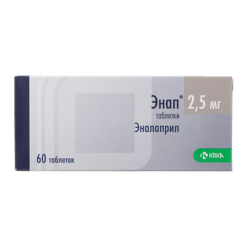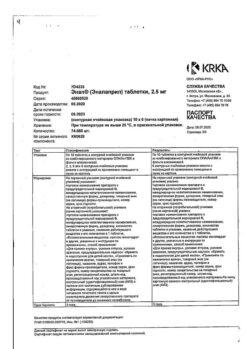No products in the cart.
Enap, tablets 20 mg 60 pcs
€11.37 €9.95
Description
An antihypertensive drug, ACE inhibitor. The mechanism of action is associated with inhibition of ACE activity, which leads to reduction of angiotensin II formation.
Enalapril is a derivative of two amino acids: L-alanine and L-proline. After absorption, enalapril taken orally is hydrolyzed to enalarylate, which inhibits ACE. Its mechanism of action is related to reduction of angiotensin I and angiotensin II formation, decrease of which in plasma leads to increase of plasma renin activity (due to elimination of negative feedback on renin production) and reduction of aldosterone secretion. Since ACE is identical with the enzyme kininase II, enalapril can also block the degradation of bradykinin, a peptide with a potent vasopressor effect. The significance of this effect in the mechanism of action of enalapril has not been definitively established.
The antihypertensive effect of enalapril is primarily associated with inhibition of RAAS activity, which plays an important role in BP regulation. Despite this fact, enalapril has antihypertensive effect even in patients with arterial hypertension and low concentration of renin.
Enalapril decreases BP regardless of body position (both lying and standing) without a significant increase in HR. Symptomatic orthostatic hypotension is rare. In some patients, it may take several weeks of therapy to achieve optimal BP reduction. Abrupt withdrawal of enalapril has not been accompanied by a rise in BP.
Effective inhibition of ACE activity usually occurs 2-4 hours after a single oral administration of enalapril. Time of onset of antihypertensive action when taken orally is usually 1 h and reaches a maximum of 4-6 h. Duration of action depends on the dose. When used in recommended doses, the antihypertensive effect and hemodynamic effects are maintained for at least 24 h.
In patients with essential hypertension, a decrease in BP is accompanied by a decrease in PPS and an increase in cardiac output, while HR does not change or changes slightly. Renal blood flow increases, but glomerular filtration rate does not change. However, in patients with a baseline low glomerular filtration rate, it usually increased.
In patients with diabetic/nondiabetic nephropathy, albuminuria/proteinuria and renal IgG excretion decreased with enalapril.
In patients with chronic heart failure (CHF) on therapy with cardiac glycosides and diuretics
administration of enalapril is accompanied by a decrease in PPS and BP, an increase in cardiac output, with a decrease in HR (usually in patients with chronic heart failure HR is increased). Pulmonary capillary congestion pressure also decreases. With long-term use, enalapril increases exercise tolerance and reduces the severity of heart failure (evaluated according to NYHA criteria). Enalapril in patients with mild to moderate heart failure slows its progression and also slows down the development of left ventricular dilatation. At left ventricular dysfunction enalapril decreases risk of development of major ischemic outcomes (including frequency of myocardial infarction and number of hospitalizations for unstable angina).
Indications
Indications
arterial hypertension,
heart failure,
asymptomatic left ventricular dysfunction (as part of combination therapy).
Pharmacological effect
Pharmacological effect
Antihypertensive drug, ACE inhibitor. The mechanism of action is associated with inhibition of ACE activity, which leads to a decrease in the formation of angiotensin II.
Enalapril is a derivative of two amino acids: L-alanine and L-proline. After absorption, enalapril taken orally is hydrolyzed to enalalrylate, which inhibits ACE. The mechanism of its action is associated with a decrease in the formation of angiotensin II from angiotensin I, a decrease in the content of which in the blood plasma leads to an increase in the activity of plasma renin (by eliminating the negative feedback to changes in renin production) and a decrease in aldosterone secretion. Since ACE is identical to the enzyme kininase II, enalapril can also block the destruction of bradykinin, a peptide that has a powerful vasopressor effect. The significance of this effect in the mechanism of action of enalapril has not been definitively established.
The antihypertensive effect of enalapril is associated primarily with the suppression of the activity of the RAAS, which plays an important role in the regulation of blood pressure. Despite this, enalapril has an antihypertensive effect even in patients with arterial hypertension and low renin concentrations.
With the use of enalapril, blood pressure levels decrease regardless of body position (both in a supine and standing position) without a significant increase in heart rate. Symptomatic orthostatic hypotension is rare. In some patients, achieving optimal blood pressure reduction may require several weeks of therapy. Abrupt withdrawal of enalapril was not accompanied by an increase in blood pressure.
Effective inhibition of ACE activity usually occurs 2-4 hours after a single oral dose of enalapril. The onset of antihypertensive action when taken orally is usually 1 hour, reaching a maximum after 4-6 hours. The duration of action depends on the dose. When used in recommended doses, the antihypertensive effect and hemodynamic effects are maintained for at least 24 hours.
In patients with essential hypertension, a decrease in blood pressure is accompanied by a decrease in peripheral vascular resistance and an increase in cardiac output, while heart rate does not change or changes slightly. Renal blood flow increases, but the speed
glomerular filtration rate does not change. However, in patients with an initially low glomerular filtration rate, its level usually increased.
In patients with diabetic/nondiabetic nephropathy, albuminuria/proteinuria and renal excretion of IgG decreased while taking enalapril.
In patients with chronic heart failure (CHF) during therapy with cardiac glycosides and diuretics
the use of enalapril is accompanied by a decrease in peripheral vascular resistance and blood pressure, an increase in cardiac output, while the heart rate decreases (usually in patients with chronic heart failure, the heart rate is increased). The pulmonary capillary wedge pressure is also reduced. With long-term use, enalapril increases exercise tolerance and reduces the severity of heart failure (assessed by NYHA criteria). Enalapril in patients with mild to moderate heart failure slows down its progression, and also slows down the development of left ventricular dilatation. In case of left ventricular dysfunction, enalapril reduces the risk of major ischemic outcomes (including the incidence of myocardial infarction and the number of hospitalizations for unstable angina).
Special instructions
Special instructions
Car drivers should use Enap with caution. When used simultaneously with diuretics and beta blockers, the effect of the drug Enap is enhanced, and with non-steroidal anti-inflammatory drugs the effect is reduced.
Arterial hypotension (a sharp decrease in blood pressure) can be observed (even several hours after taking the first dose) in patients with severe heart failure or severe renal impairment, as well as in patients with fluid and electrolyte imbalance caused by treatment with diuretics, a salt-free diet, diarrhea, vomiting, or those on hemodialysis. A marked decrease in blood pressure (BP) usually manifests itself in the form of nausea, increased heart rate (HR) and fainting.
If arterial hypotension develops, the patient should take a horizontal position with a low headboard and call a doctor.
Active ingredient
Active ingredient
Enalapril
Composition
Composition
Active ingredient:
enalapril maleate 20 mg.
Excipients:
lactose monohydrate,
hydroxypropylcellulose,
corn starch,
sodium bicarbonate,
talc,
magnesium stearate.
Contraindications
Contraindications
hypersensitivity to enalapril or other components of the drug,
hypersensitivity to other ACE inhibitors,
history of angioedema, including those associated with the use of ACE inhibitors (an allergic reaction with severe swelling of the lips, face, neck and possibly arms and legs, accompanied by suffocation and hoarseness),
porphyria,
patients who have ever had angioedema.
Side Effects
Side Effects
dry cough,
pharyngitis,
laryngitis,
dizziness when standing upright, palpitations, chest pain,
impaired renal function and blood picture,
nausea, vomiting, abdominal pain,
skin allergic reactions,
headache, depression, sleep disturbances,
increase in potassium in the blood.
Interaction
Interaction
The patient should refrain from drinking alcoholic beverages, since ethanol enhances the reduction in blood pressure (BP) by enalapril.
The simultaneous use of enalapril and diuretics or other antihypertensive drugs increases the effectiveness of these drugs.
Interactions with drugs used to treat heart failure (cardiac glycosides) are not clinically significant.
Before surgery, you should inform the doctor that the patient is taking enalapril, since there is a risk of developing arterial hypotension during general anesthesia.
The simultaneous use of enalapril and non-steroidal anti-inflammatory drugs (NSAIDs) or acetylsalicylic acid (aspirin), as well as estrogens, may reduce the effectiveness of enalapril and increase the risk of renal dysfunction.
The simultaneous use of certain diuretics (spironolactone, amiloride or triamterene) and/or the addition of potassium tablets may cause an increase in serum potassium levels (hyperkalemia).
Medicines that cause bone marrow suppression increase the risk of developing neutropenia and/or agranulocytosis.
Immunosuppressants, allopurinol, cytostatics increase hematotoxicity.
Enalapril weakens the effect of products containing theophylline.
Concomitant use of lithium preparations may increase the side effects of lithium.
When taking the drug Enap simultaneously with cimetidine, the half-life (T 1/2) of Enap increases. If the patient is already taking the above medications or is advised to take any of them, he should tell the doctor that he is taking Enap.
Overdose
Overdose
If the patient has taken too many tablets at one time, call a doctor immediately.
Symptoms: excessive decrease in blood pressure (BP) up to the development of collapse, myocardial infarction, acute cerebrovascular accident or thromboembolic complications, convulsions, stupor.
Treatment: the patient is transferred to a horizontal position with a low headboard. In mild cases, gastric lavage and ingestion of saline solution are indicated; in more serious cases, measures aimed at stabilizing blood pressure (BP), intravenous administration of saline, plasma substitutes, and, if necessary, intravenous administration of angiotensin II, hemodialysis (enalaprilat elimination rate – 62 ml/min).
Storage conditions
Storage conditions
Store in a place protected from light at a temperature not exceeding 25°C.
Manufacturer
Manufacturer
KRKA-RUS/KRKA, Russia
Additional information
| Conditions of storage | Store in a light-protected place at a temperature not exceeding 25°C. |
|---|---|
| Manufacturer | KRKA dd Novo mesto, Slovenia |
| Medication form | pills |
| Brand | KRKA dd Novo mesto |
Other forms…
Related products
Buy Enap, tablets 20 mg 60 pcs with delivery to USA, UK, Europe and over 120 other countries.

